Geosynthetics are building materials intended for creating layers for various purposes. One of the varieties of geosynthetics is geotextile. Specific features of production and versatility of this fabric allow it to be used not only in construction, but also in the furniture industry, gardening and landscape design.
Content
- 1 Geotextiles
- 2 Geotextile properties and characteristics
- 3 Universal geotextile. Areas of application in the private sector
- 3.1 protection of waterproofing of concrete structures
- 3.2 effective filter and protection of pipes underground
- 3.3 geotextile for the arrangement of roofs
- 3.4 improvement of access roads, sites and paths
- 3.5 arrangement of artificial reservoirs
- 3.6 arrangement of yards and plots
- 3.7 geotextile in horticulture and vegetable growing
The initial purpose of geotextiles is to create a layer that prevents mixing of soil layers, protection against landslides, landslides and other soil damage. Modern technologies allow producing geotextiles of improved quality, this makes it universal and allows the application in a wide variety of industries and the national economy, as described on the website http://dorpir.ru/.
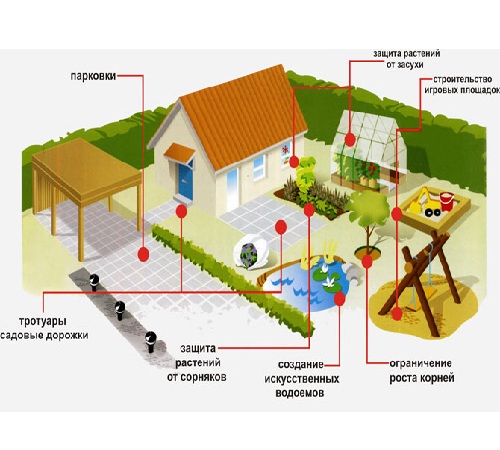
Geotextile, like all geosynthetics, features increased elasticity, resistance to stress and mechanical damage, high strength and reliability. Such material is able to perform reinforcing functions, has resistance to ultraviolet, has excellent filtering qualities. One of the important advantages of geotextiles is the ecological purity of the material.
Geotextiles
Geotextile material can be woven (geotextile) or non-woven (geolocate).
Geotkan - woven geotextile. The material is obtained by interlacing synthetic filaments. Such a canvas is high-strength, water-permeable, resistant to deformation and tearing. These characteristics make it possible to use geotextile as a reinforcing component to increase the stability and bearing capacity of soils, and to enhance complex landslide soils. Due to the strength and peculiarities of geotectic production, it is used in the construction of dams and in shore protection, for this purpose special volume structures (geocontainers, geotubes) are closed.
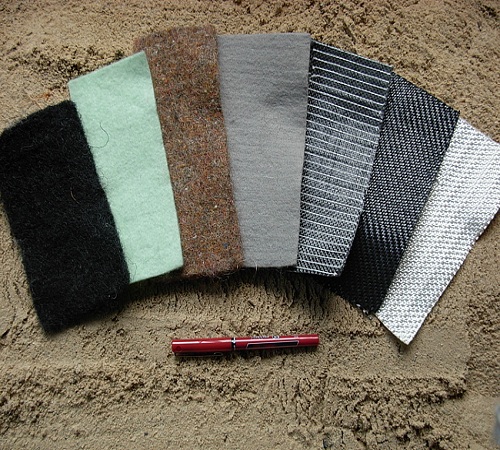
Geopolotno is a non-woven geotextile. Basically, the geolocation is used as a separator of different in its structure layers. Such a water-permeable, strong and flexible web is obtained by bonding synthetic (polypropylene, polyester) yarns or fibers in various ways:
- Chemical (adhesive). It is obtained by gluing together the filaments of polymers.
- Thermal (thermofixing). The web is produced by fusing propylene yarns.
- Mechanical needle-punched method. At the heart of this fabric are polyester yarns (polyester).
geotextile Dornit. Key Features
The most popular among consumers is the type of geotextile - Dornit. Dornit is a geotextile produced by Russian developers based on French technology by mixing different methods and polymeric materials. It is generally accepted that Dornit geotextile is a non-woven polymer material produced by the needle-punched method. However, still, this is a common name for a line of Russian nonwoven and woven geotextile cloths made by various combined ways of joining the fabric (mechanical, thermal).

Initially, geotextile Dornit was developed for use in laying roads and building buildings. At present, the material is used in the construction of foundations, roofing, in land management for the creation of drainage and proto-erosive structures, filtration, reinforcement and separation of layers of different types, as well as in landscape design and landscaping, as it strengthens and protects soils from landslides, landslides and weathering .
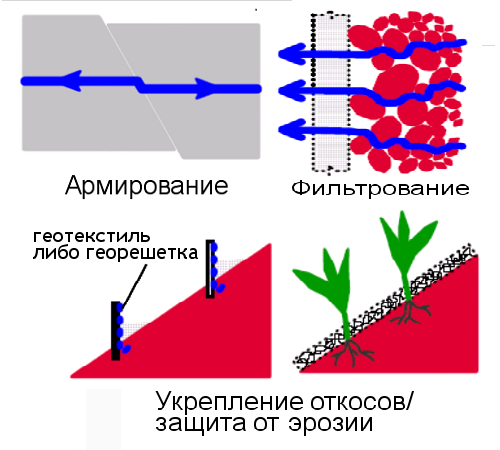
Geotextile properties and characteristics
Geotextile has a high resistance to thermal and oxidative aging and aggressive chemical attack of media, is not susceptible to rotting, infection with fungi, mold, indifferent to rodents. The structure of the material is such that it easily passes moisture and water, but completely detains particles of earth, sand and other soil. In this case, the web is not subject to organic decomposition and does not release toxic and chemically harmful compounds into the environment.
In the construction market, different brands and types of such material as geotextiles are available, the technical characteristics of which differ slightly depending on the manufacturer. Average values can be found in the table below:

As additional positive characteristics should be allocated:
- Elongation at tension, preventing tearing of the material. The relative elongation of the geotextile web under the action of maximum tension is up to 45%. This allows the material to transfer local loads over a long period.
- High filtering performance in conditions of maximum soil pressure with strong vibration.
- Quick and easy installation. Easy to process.
Universal geotextile. Areas of application in the private sector
Manufacturers of geotextiles are supplied in rolls. The length of the canvas in the roll is 100-350 m, width - from 1,6 to 6 m. The density of the material is from 80 to 600 g / m 2.
The application of the material depends on the density of the web. For example, a nonwoven fabric (150 - 200 g / m²) is advisable to use as a filtering material in drainage systems, for protection against weeds and arrangement of tracks. Geotextile non-woven medium density (200-350 g / m²) is used to protect the soil from erosion, separation of soil layers and soil consolidation. Geotextile non-woven tight (350 - 600 g / m²) is recommended for use as a cushion in geomembranes, as a layer separator in the construction of roads and as a protective material for the construction of dams, pools, coastal zones.
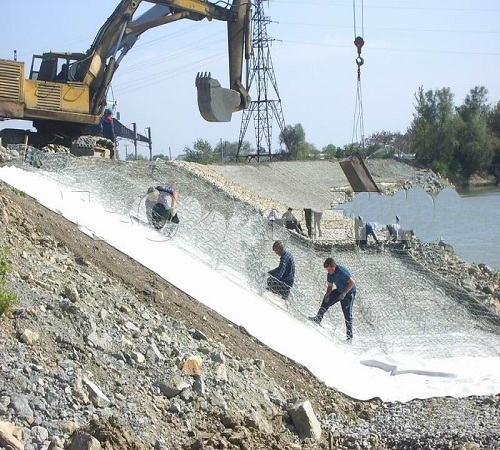
protection of waterproofing of concrete structures
The main danger for concrete structures is the capillary wetting by groundwater. That is why the waterproofing of a monolithic foundation is not completely reliable despite its quality. An auxiliary layer for the arrangement of waterproofing of a monolithic foundation is geotextile. Its peculiarity lies in the fact that the separation of gravel underfill from the fine-grained soil closes the mixing of the layers, and, hence, any possibility of wetting the walls.
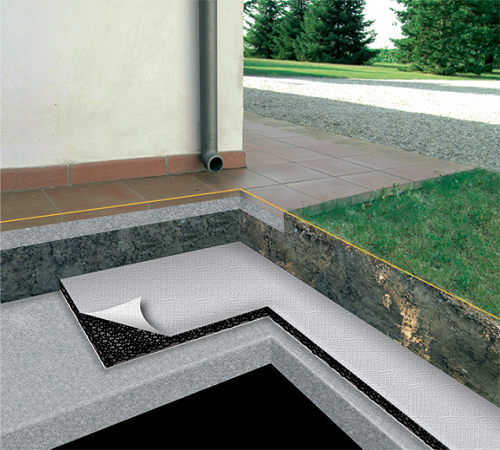
In addition, the use of this material can provide an effective drainage, preventing long-term contact of concrete structures with moisture. Geotextiles are used in the form of protection of drainage pipes and layer separator.
effective filter and protection of pipes underground
Geotextile is an excellent filter material: when water passes through the material, soil and soil particles are retained. To ensure effective drainage, the best option is to use perforated pipes. To protect the pipes from clogging, you can use geotextiles. This material is necessary to wrap the pipes.
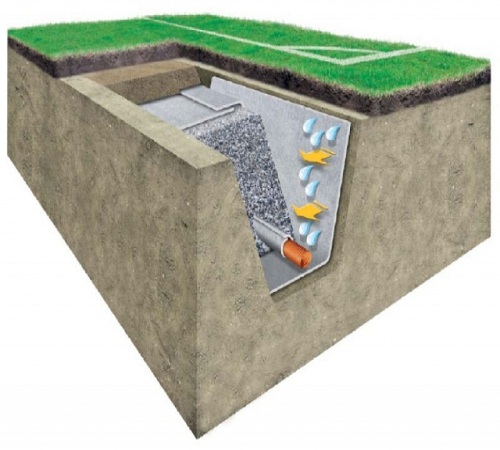
For rapid drainage of the territory, pipes are often placed in a drainage gravel layer, in which case the geotextile filter retains its structure and permanently separates the drainage from the ground. With regard to the use of autonomous sewerage, in this case, the geotextile shell around the gravel gives excellent aeration, which contributes to efficient biotransformation of the effluent.
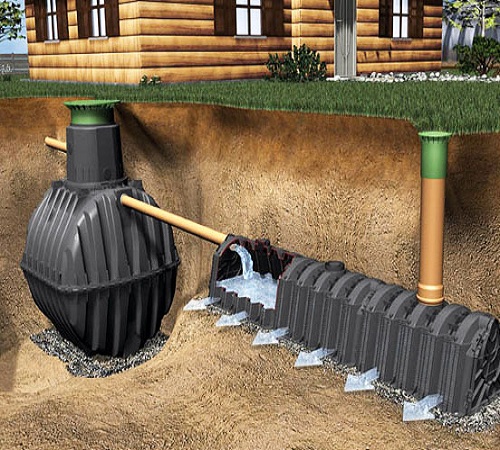
geotextile for the arrangement of roofs
An important role geotextile plays in the arrangement of roofs. When installing inversion roofs, it is laid on the heater, eliminating the penetration of the particles of the load layer between the layers of insulation. In the case of the device of green roofs, the geotextile is placed above the waterproofing layer, but between the humus and the drainage layer. This protects the waterproofing of the roof from damage when mixing these layers.
Geo-textiles of increased density can be used as a reinforcing substrate in the technology of obtaining insulating layers by applying bitumen emulsions. Thus, the compression and expansion of the substrate decrease with sharp temperature fluctuations.
improvement of access roads, sites and paths
Works on laying access roads to the house, garden paths and sites are a laborious process. Gradually, the soil sags and instead of smooth paths and areas, irregularities and swings occur.
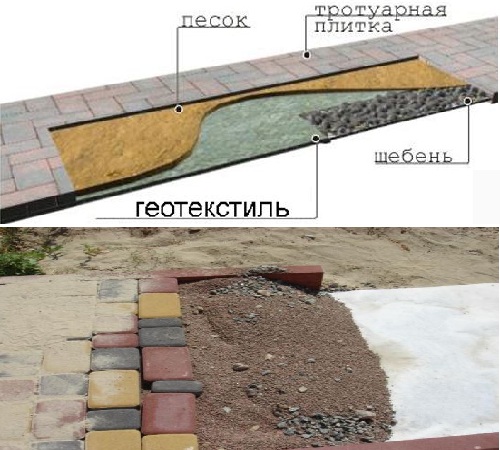
The use of geotextiles does not allow soil layers to mix and redistribute the load evenly over the entire surface. Drainage geotextiles laid between the soil and bulk material, delays the penetration of sand and gravel into the ground, promotes effective drainage, improves the distribution of loads on supports, prevents the spread of grasses and weeds.
arrangement of artificial reservoirs
When equipping both complete swimming pools and small decorative reservoirs, the construction of a waterproofing layer is required. At the same time, there is an increased risk of damage to the protective waterproofing layer by plant roots or protruding edges of stones. Geotextile comes to the aid: laid under a layer of waterproofing, it protects waterproofing materials from damage.

If you additionally lay a textile cloth over the base of the reservoir, you can lay out the bottom with beautiful decorative stones.
arrangement of yards and plots
The use of geotextiles makes it possible to more efficiently arrange functional zones of yards and areas in the private sector. The material makes it possible to reinforce the soil more effectively. This makes it possible to build high embankments in yards, realizing various ideas of geoplastic landscape improvement. Geotextile perfectly passes moisture and air, but does not allow the germination of weeds and the appearance of insects and rodents. The material is recommended to use for creating stony gardens, man-made embankments and playgrounds, in order to minimize or completely prevent the growth of unwanted plants.
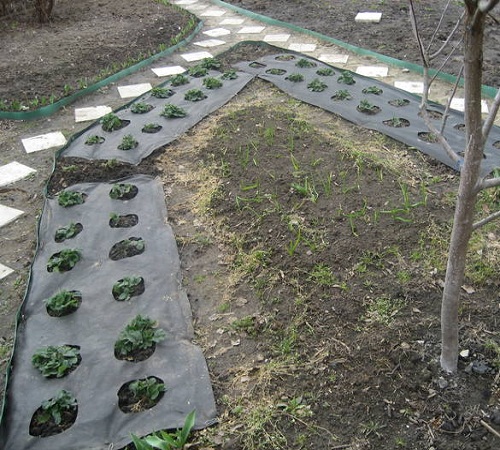
There are special types of geotextiles that are used in sandboxes: do not allow sand to mix with soil and earth, prevent the subsidence of the sand layer.
geotextile in horticulture and vegetable growing
The versatility of geotextiles opens up extended possibilities for gardeners and truck farmers: it can be used to simplify the process of growing horticultural produce, to increase yields, to control weeds. Geotextiles laid on top of infertile soils (beneath the loose soil) prevent the washing out of the fertile layer and allow the preservation of all useful elements in it. This in turn increases crop yields.
Some special types of geotextiles are designed to prevent germination of weeds and mulching. Having made holes in the layer of material, you can get rid of laborious weeding. At the same time, only cultivated plants remain on the surface, which provides the most favorable conditions for their growth. This technique is used for both vegetables and berry crops, as well as for ornamental plants and flowers in flower beds.

With the use of geotextiles it is possible to prevent the growth of tree roots in the direction of garden paths, foundations, access roads, as the garden geotextile forces the branched root system to grow vertically, eliminating future problems from the site.
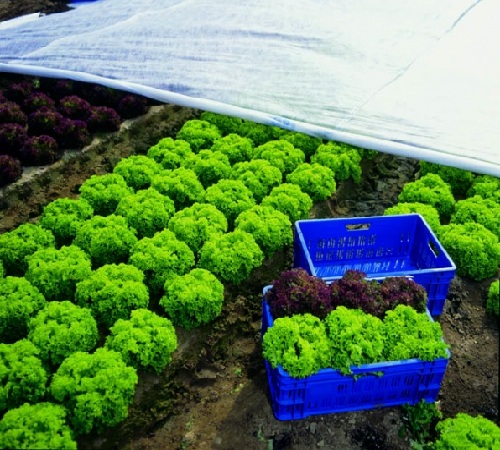
Particular danger to plants in the transition period are night frosts. The use of geotextiles gives plants protection not only from frost, but also from the bright scorching sun in the summer. Geotextiles are so versatile that it can be used for any layer in any desired place. For example, when growing seedlings and plants in pots, such a canvas creates an excellent drainage system, not permitting mixing of the layers of coarse fraction filler and bulk soil.
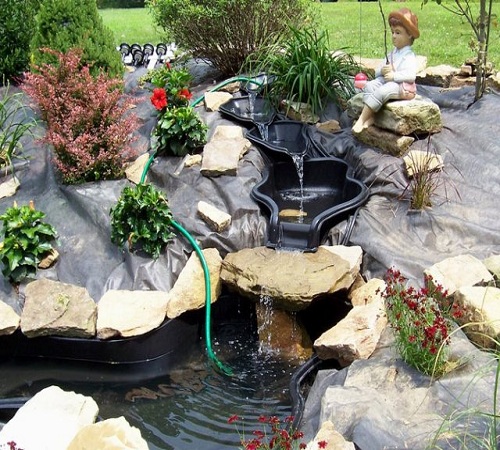
Geotextile is a universal, easy-to-use, environmentally friendly material. To lay it does not need special skills or knowledge, it is available to any person.



















